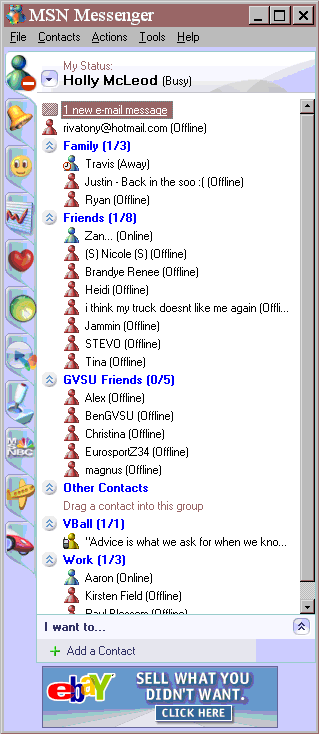
What is Instant Messaging? | History | Uses | Experience | Advice
Instant messaging is a form of online communication that has rapidly gained popularity in parallel with the Internet itself. Instant messaging involves having an application with a list of people, often called a "buddy list" or "contact list" that one can communicate with. This application will indicate if any of the people in the list are online. If they are, a user can instantly send a message to any of those people, and a small window will appear on the recipient's screen with the sent message. The recipient can then respond to the message, and an online conversation is started between the two users. Instant messaging is personal, informal, and gets quick results.
Instant messaging has become so popular, that several companies have developed their own applications. Some of the most commonly used include AIM (AOL Instant Messenger), MSN Messenger, ICQ, and Yahoo! Messenger. New Instant Messengers, like Odigo and Omni, allow users to combine contact lists from AIM, MSN Messenger, ICQ, etc, into one system. This is convenient because not all users have the same messaging application.
Before the Internet became popular, the most common way people communicated online was through bulletin boards. These are applications where discussion topics or questions are posted, and others respond if they have an answer or something to say on the subject. However, as the Internet became more popular, and people began spending more time online, the need for a real time, easier to use application was realized, and online services were developed.
Think of an online service as a very sophisticated bulletin board. Whereas most small bulletin boards use standard communications software, online services provide a complete application that includes the communications software necessary to connect to their service. This application also includes the actual interface that people use once they are online and connected to the service. This allows the online service to create a very sophisticated and targeted experience for their users.
The first such services were chat rooms and instant messaging. Chat rooms were popular, but the Instant Messenger grew in popularity even more because of its personal nature. In a chat room, users must post discussion were many other people can see it. With instant messaging, only the intended user sees the message. ICQ was the first instant messaging service developed, AIM came second, and all the others came soon on their heels. Visit HowStuffWorks.com to see more detailed information about Instant Messaging actually works.
Instant messaging applications have evolved to be much more than a replacement for email. Depending upon the brand of Instant Messenger (AIM, MSN, ICQ, etc), these applications are now used for a variety of different tasks. Some of these are:
Personally, I have used many Instant Messengers. I have the most experience with AIM and MSN Messenger, but have also used ICQ and Yahoo! Messenger. Each of these applications provides similar services. The biggest difference I have found is in the user interface. Some are very easy to navigate and to accomplish tasks with. Others, however, are more of a puzzle to figure out. For example, simply adding a "buddy" or "contact" to your list is accomplished in different fashions on each platform.
I have used Instant Messengers to share files, share photos, talk, and simply to message. I have friends, family, and co-workers in my contact list, and I frequently talk to all of them. I use it most often to communicate with my friends about plans for an upcoming weekend, or with a question about classes or homework. I have found instant messaging to be a useful tool because of its immediate feedback. It is nice to know if someone is online, since if they are you can just talk to them instead of sending an email that they may not open until two days later. You can also set how other people see you when you are online. This is called your "status", and in all the Instant Messenger applications, you have options. You can set it to "Away" or "Busy" or "Out to Lunch". This is nice to let others know what you're doing if you want to.
I recommend using Instant Messaging to communicate with your family, friends, and co-workers. It is convenient and quick, and it is free! I suggest using it to talk to people who are long distance from you instead of using the telephone. A long distance phone call often costs money, but instant messaging does not!
My specific advice is to use MSN Messenger. Out of the many services I have used, I like its user interface best. It is easy to accomplish tasks like adding and deleting contacts, and its settings are easy to change from menus at the top. It also provides a multitude of services through the messenger, like free streaming radio, stock quotes, games, news, travel information, and local traffic and gas prices. You can personalize your MSN Messenger with photographs as well. It is a well-rounded application. Another feature unique to MSN Messenger is that it will tell you if you have any new email. This is great so you do not have to constantly refresh your email window to see if new messages have arrived. Below is an example of the MSN Messenger interface, with several contacts already loaded.
